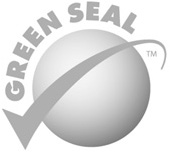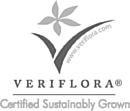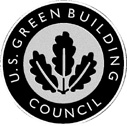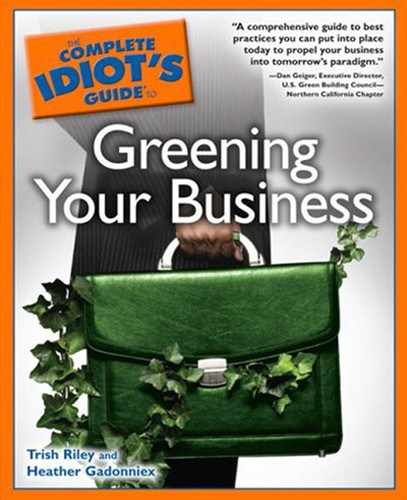In This Chapter
Finding eco-labels for your business
The value of eco-labels
Confirming legitimacy
Understanding the wide selection of labels
One good way to let your customers and colleagues know you’re working to make your business sustainable is to seek the stamp of approval from bona-fide green certification programs. When you can demonstrate that you’ve passed through the highest standards, whether by obtaining LEED certification for your building from the U.S. Green Building Council (USGBC) or as a green business member of Green America, your customers will know you’re vetted as a genuinely green and sustainable business.
Because many green credentials are popping into the market, you should know the validity of available programs so you can choose the best allies for your business. In this chapter, we provide a review of several eco-label programs we hope will help you make the best, well-informed decisions for your company. This chapter reviews only a fraction of the eco-labels available today. To access a comprehensive guide to eco-labeling, visit www.greenitgroup.com.
The increase in green marketing initiatives has spawned a rampant increase in the number of certifications available in the green marketplace. Many different types of organizations—including nonprofits, for-profits, and government agencies—have developed eco-labels. The validity, breadth, and issues each address vary. From energy efficiency to organic food, it’s often tricky to differentiate the good, better, and best. Sorting through the sea of certifications can often be a grueling task.
Understand that just because a product has an eco-label doesn’t mean every aspect of that product or company is green. For example, GreenGuard provides an eco-label for indoor air quality, and products bearing the GreenGuard seal of approval meet certain tests for improved indoor air quality and volatile organic compound (VOC) emissions. But just because one aspect of the product is green does not necessarily mean the entire product is a green product. For example, GreenGuard certification does not cover other green product aspects, such as raw materials, end-of-life disposal, or production and company sustainability practices. Another example would be an Energy Star–certified product. This eco-label, which you can find on many kitchen appliances, washing machines, and computers, focuses on energy use during equipment operation. Again, meeting this standard does not necessarily mean the entire product has been scrutinized through a lens of sustainability.
Note
An eco-label identifies a product that meets specified environmental performance criteria or standards. Awarded by a third-party organization to products or services, this document provides an overview of eco-labels, including a summary of programs for electronic products in the United States and abroad.
The International Organization for Standards (ISO) is the world’s largest developer and publisher of international standards. Comprised of a network of 157 countries, this nongovernmental organization forms a bridge between public and private sectors. According to the ISO, three broad types of environmental labels exist:
Type I environmental labeling (ISO #14024:1999)—. This voluntary, multiple criteria–based, third-party program awards the license to use an eco-label developed by the third party. These types of labels assess multiple product criteria, are based on the life cycle of the product, and are awarded to the best environmental performers.
An example of this type of eco-label is the Green Seal. It assesses a product using a multiple-criteria, life cycle–based method. Products that pass the testing criteria are awarded the Green Seal.
Type II self-declared environmental claims (ISO #14021:1999)—. These claims are made by the company (hence, self-declared) and are often difficult to verify. Text, symbols, and eco-friendly terminology are used to emphasize a particular environmental aspect of the product or service. Type II labels cover only one eco aspect of a product.
If a manufacturer creates a recycled content label for their product, claiming that the product contains x amount of recycled content, they are following the Type II guidelines.
Type III environmental declaration (ISO/TR #14025:2000)—. These voluntary programs provide quantitative environmental data of a product under pre-set categories of parameters set by a third party and verified by that third party. Think of this type of label as a report card that shows how much water, energy, and materials the product uses.
An environmental product declaration (EPD) that is verified by a third party is an example of a Type III claim.
Consensus shows that eco-labels influence consumer-purchasing behavior. Consumer demand for green everything has led many organizations to create a green story, backing it up with a homemade eco-label. In 2008 alone, countless new eco-labels have hit the shopping isles, promising everything from a reduced carbon footprint to being just plain green without qualifying why or how. Often, these labels are based on a lack of knowledge about environmental issues and green product criteria as marketing departments just seek out an angle, design a label, and slap it on a product.
Recently a major clothing retailer debuted an eco-label highlighting the green products in a number of stores. The label, which adorned a wicker basket, made the claims of biodegradability and eco-friendly. However, the overall product was composed of certain components that were not biodegradable. This self-made eco-label is a liability both for the store and the customer purchasing the product. Not only is the retail outlet misleading the customer by making false environmental claims, but the customer could also cause further environmental damage by disposing of the product in an improper manner, which could lead to increased disposal costs. This is a good example of greenwashing.
Note
A material is called biodegradable when microorganisms such as bacteria, enzymes, and fungi can degrade it. This degradation produces water, carbon dioxide (CO2) and/or methane, and in some cases nontoxic residues.
Verifying the accuracy and validity of eco-labels is extremely important. Ask yourself the following questions:
Is this eco-label made by the same company that is producing the product?
Is the eco-label self-certified?
Is a credible third party providing the eco-label?
What standards does the product or organization have to meet to obtain the eco-label?
Are the standards that the product or organization has to meet publicly available?
Is the label consistent in its meaning?
Does the organization have verifiable data to back up the claims made on the eco-label?
Was the label developed with pubic and industry input?
When a credible outside source gives an eco-label to a product or organization, there is a greater chance the label will be genuine. Third parties who provide transparent labeling criteria provide measurable, replicable standards for products and add a tremendous amount of credibility to any eco-label. Transparency is the key to success, so look for eco-labels that list their green product criteria for all to review. And beware of third parties who sell eco-labels without allowing the public to view their certification criteria.
An example of a genuine eco-label is Forest Stewardship Council’s (FSC) certification for sustainable forestry initiatives. Formed in 1993, FSC is an international, independent, third-party group of certification bodies that assess forest management for sustainable forest management activities and chain-of-custody tracking of sustainable wood products that originate from FSC-certified forests. Third-party certifiers work with landowners to bring their forests up to transparent standards, which were developed by a large group of external stakeholders.
Other eco-labels are not so transparent. An organization in Florida that certifies businesses for being green charges a fee for certification. After it collects the fee, the organization sends out guidelines. The participating business has to fill out the guidelines, sign them, and fax them back. Then the business receives a plaque, a green plastic wristband, lapel pins, and a window decal. There is no verification of the participating business’s answers to the questionnaire, nor any guarantee that the participating business is implementing environmental reduction strategies into their business model. Also the guidelines are proprietary, not transparent, and are not available for public review or comment. Although this certification is not transparent or third-party verifiable and auditable, it is a positive step in an overall shift in awareness and adoption of green business practices. But do be aware that the green movement, like any new market trend, provides business opportunities that can be exploited by less-than-scrupulous people looking to make a buck without any real interest in the underlying goals of the movement. Watch out for unnecessary middlemen selling snake oil.
Hazard

When searching for the appropriate eco-label for your product or organization, make sure the standards required to meet the labeling criteria are publicly available. For the most genuine eco-label, seek independent third-party verification for your certification.
If you are looking to certify your organization for its efforts in implementing green or sustainable business practices, research B Corporation and Green America’s green business membership. These are two credible organizations that offer sustainable and green business certifications. Also check to see if your city or town has a reliable, transparent green business program and certification.
Eco-labels are not always what they seem; many are irrelevant, and even more boast ambiguous claims that may be unfounded or irrelevant. Labels such as natural, free range, and CFC-free all sound wonderful, but what are these environmental labels really saying?
According to Ecolabels.org, a food labeled “natural” can contain artificial sugars and oils or partially hydrogenated oils. Meat labeled “natural” pertains only to how the cut of meat was processed and not how the animal was raised. Depending on the type of meat, natural meat may contain added synthetic antibiotics and hormones. According to the USDA, producers of free-range meat must demonstrate that the poultry was allowed access to the outside, not that they necessarily spent time outdoors.
CFC-free means a product does not contain any chlorofluorocarbons, chemical substances that can deplete Earth’s protective ozone layer. The ozone layer absorbs 93 to 99 percent of the sun’s ultraviolet light, and this protection is vital to the existence of life on Earth. According to the Federal Trade Commission (FTC), CFCs were banned in 1978 for use in propellants in nearly all consumer aerosol products. A CFC-free eco-label is therefore irrelevant and misleads consumers by portraying the product as eco-friendly when it is simply complying with the law.
Note
CFC-free means free of chlorofluorocarbons (CFCs), synthetic chemicals that can damage the layer of atmospheric ozone protecting Earth. CFCs were banned from products in 1978.
When assessing eco-labels for products you produce and the products you purchase, look beyond the logo and analyze the label in depth. Labels are not always what they seem.
Third-party certification and verification is one of the most trusted ways to obtain an eco-label. Products that bear a third-party logo are often the most authentic in terms of environmental claims, as long as the third party provides transparent certification criteria. Utilizing a well-recognized third-party provider of eco-labels is an effective way of creating a credible green story.
Third-party agencies work with product manufacturers and suppliers to obtain the necessary data needed to analyze the product to meet the certain criteria for each specific certification.
Following are a few examples of third-party-certified eco-labels.
Green Seal provides science-based environmental certification standards that are credible, transparent, and essential in an increasingly educated and competitive marketplace. Founded in 1989, Green Seal is well respected in the environmental community, utilizes internationally recognized standards, and is nonprofit. To earn a Green Seal stamp of approval, products must meet the outlined environmental standards developed for the specific product category, undergo scientific testing, and provide a tour of the product’s manufacturing facility. Green Seal reviews the manufacturing process and the use and ultimate disposal of the product. A product performance review ensures that all certified products work as well or better than other products in their individual product category. All Green Seal standards are set through an open, collaborative process that includes stakeholders from all industry sectors, including consumer groups, government, universities, trade associations, manufacturers, and the public. Each year, products that received Green Seal certification must participate in a review. For a list of Green Seal–certified products, visit www.greenseal.org.

Green Seal stamp of approval.
(Courtesy Green Seal program)
Scientific Certification Systems (SCS) offers a diverse range of eco-labels. Since 1984, SCS has been providing independent verification of environmental claims made by manufacturers regarding products and service qualities such as biodegradability, recycled content, and water efficiency. SCS also is a certifier for the previously mentioned FSC certification and Veriflora, a sustainably grown floral certification.

Veriflora seal.
(Courtesy Veriflora)
Scientific Certification Systems seal.
(Courtesy Scientific Certification Systems)
Perhaps the most well-known third-party eco-verification label is the USGBC’s Leadership in Energy and Environmental Design (LEED) certification. The USGBC is a nonprofit, nongovernmental organization whose mission is to transform the way buildings and communities are designed, built, and operated, enabling an environmentally and socially responsible, healthy, and prosperous environment that improves quality of life.
The USGBC, formed in 1993, has grown to comprise over 15,000 organizations from across the building industry. According to the USGBC, members include building owners and end-users, real estate developers, facility managers, managers, architects, designers, engineers, general contractors, subcontractors, product and building system manufactures, government agencies, and nonprofits.
The LEED certification system is a tiered system that addresses the built environment. Buildings earn LEED certification through the accumulation of points from four levels: certified, silver, gold, and platinum. With the LEED rating system, the USGBC transformed the building industry by creating a certification for buildings. It also created a certification for people qualified as LEED-accredited professionals. Building product manufacturers, architects, designers, city planners, and consultants all work together to create a more sustainable built environment and achieve the stringent LEED rating standards. LEED is the perfect example of a successful, third-party eco-certification that unified industry to create a market shift toward sustainability.

USGBC seal.
(Courtesy U.S. Green Building Council)
Eco-labels cover more than just environmental issues. The Fair Trade Certified logo ensures that strict environmental and social criteria were met in the production of trade and agricultural products. Purchasing Fair Trade Certified products ensures that you are contributing to the empowerment of farmers and farm workers. Procurers of Fair Trade Certified products provide high wages to farmers, allowing them to rise out of poverty and reinvest in their communities. This certification encompasses environmental protection as well as social development.
The U.S. government provides its Energy Star certification program to let consumers know that products bearing its seal have been assessed and approved as the most energy-saving, efficient models on the market. The EPA introduced Energy Star in 1992 as a voluntary eco-labeling program developed to promote energy-efficient products to consumers and reduce greenhouse gas emissions. The widely recognized eco-label is seen on appliances such as refrigerators, stoves, washing machines, office equipment, home electronics, lighting, and much more.
Recently, the EPA Energy Star ratings have come under fire recently. In its October 2008 issue, Consumer Reports reported that its tests of Energy Star appliances indicated some were less than half as efficient as the manufacturer claimed and the Energy Star label backed up. The magazine said standards are lax and that several loopholes exist that give the sales-promoting certification to products which don’t deserve it.
The EPA responded that it stands by the integrity of the program and its certifications.

Energy Star seal.
(Courtesy EPA Energy Star)
The EPA recently launched the WaterSense program to make it easier to purchase products that save water. Much like the Energy Star program, products which meet EPA standards are labeled with the WaterSense logo. According to the EPA, “When you use products bearing the WaterSense label, you can expect exceptional performance, savings on your water bills, and assurance that you are saving water for future generations.” To find products that meet WaterSense criteria, visit www.epa.gov/watersense/pp/index.htm.

WaterSense logo.
(Courtesy EPA Water Sense)
Eco-labels exist around the world. The United States is actually behind the times when it comes to labeling products for environmental and social attributes.
The following is a list of well respected eco-labels from around the globe:
Blue Angel (Germany)—. The Blue Angel is Germany’s eco-label. Created in 1977, it is one of the oldest eco-labeling programs in the world.
Eco Mark (Japan)—. The Japan Environment Association develops environmental standards and permits products to bear the Eco Mark symbol.
Environmental Choice (New Zealand)—. The New Zealand Ecolabelling Trust is a voluntary, multiple specifications–based environmental labeling program initiated and endorsed by the New Zealand government.
Environmental Choice Program (Canada)—. The Environmental Choice Program (ECP) is Environment Canada’s eco-label program which certifies environmentally preferable products based on multi-attribute life-cycle criteria.
Environmental Label Award (Croatia)—. The Environmental Label is awarded by Croatia’s Ministry of Environmental Protection for products certified as meeting specific environmental performance criteria.
European Commission, Green Public Procurement—. Policies, resources, and guidance from the European Commission are designed to increase the level of green public procurement in the European Union member states.
European Union (EU) Eco-Label—. The EU Eco-Label is a voluntary program designed to encourage businesses to market products and services that are kinder to the environment. It is used throughout the European Union as well as in Norway, Liechtenstein, and Iceland.
Global Ecolabelling Network (GEN)—. GEN is a nonprofit association of third-party, environmental performance labeling organizations founded in 1994 to improve, promote, and develop the eco-labeling of products and services.
Good Environmental Choice (Australia)—. Good Environmental Choice is Australia’s environmental performance eco-label. It is based on product life cycle.
Hong Kong Green Label Scheme (HKGLS)—. HKGLS is an independent, not-for-profit and voluntary scheme for the certification of environmentally preferable products launched in 2000 by the Green Council and the Hong Kong Productivity Council.
Green Mark (Taiwan)—. Green Mark is Taiwan’s program to guide consumers in purchasing green products and to encourage manufacturers to design and supply environmental benign products.
Green Purchasing Network (Japan)—. The Green Purchasing Network (GPN) was established in February 1996 to promote green purchasing among consumers, companies, and governmental organizations in Japan.
Korea Eco-Label—. The Korea Eco-Labeling Program certifies qualifying eco-products for excellent quality and performance, as well as general environmental friendliness during the entire production process.
National Programme for Labelling Environmentally Friendly Products (Czech Republic)—. The Czech Eco-Labelling Agency manages the Czech National Eco-Labelling Programme, which labels environmentally friendly products.
NF Environnement Mark (France)—. The NF Environnement mark is the official French ecological certification.
Organization for Economic Co-Operation and Development (OECD) Environmental Directorate—. The OECD Environment Directorate is an international organization that provides governments with the analytical basis to develop environmental policies that are effective and economically efficient.
GreenLabel (Singapore)—. The Singapore Green Labelling Scheme was launched in 1992 by the Ministry of the Environment and awards the GreenLabel to products meeting specific environmental criteria.
Swan Eco-Label (Nordic Countries)—. The Swan is the official Nordic eco-label introduced by the Nordic Council of Ministers.
TCO Development (Sweden)—. TCO Development provides certification and environmental labeling of office equipment designed to improve the work environment and the external environment.
Thai Green Label Scheme (Thailand)—. The Thai Green Label Scheme, launched in 1994 by the Thailand Environment Institute in association with the Ministry of Industry, awards the Green Label to products meeting specific environmental criteria.
You can choose from many eco-labels, which you’ll find on a variety of products whose manufacture and use impact the earth in many ways, from energy, oil, and water usage to waste produced during manufacture and use. These seals can help you ensure that your efforts to make your business sustainable and Earth-friendly will be successful.
Products on the market use many types of eco-labels.
Most eco-labels are legitimate and use genuine standards to determine the eco-friendliness of a product and/or business.
Invalid label programs are available that cost money but don’t provide any useful or legitimate rating.
Taking time to familiarize yourself with labels will help you make the right choices in purchasing as well as in seeking eco-labels for your own business.

